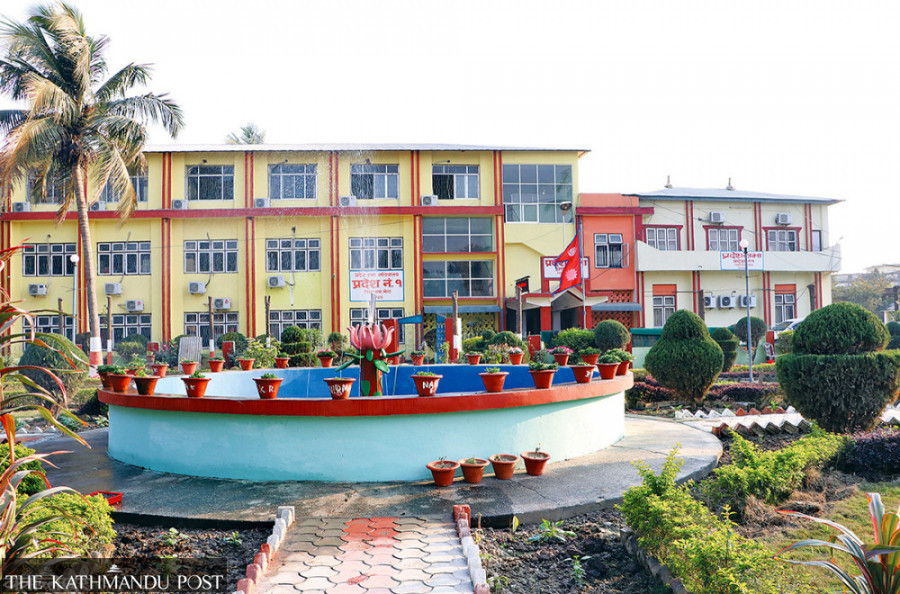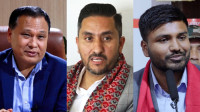National
Provinces failed to live up to federal dream
Provincial governments spent 5 years accusing Kathmandu of rendering them ineffective.
Post National Bureau
The 2015 constitution envisions three tiers of government—federal, provincial and local—and it has distributed state powers with separate lists of exclusive, concurrent and residual powers of the three governments.
Under this arrangement, the constitution has enumerated the exclusive powers to be exercised by each tier of government and concurrent powers between these governments. Also, the statute states that the federation shall have power on any matter not enumerated in the list of powers of the federation, province and local level or concurrent lists or on any matter not specified in the constitution as to be exercised by any level.
Under this concept, the federal government has a facilitator’s role and the authority to prepare an umbrella law to implement federalism. However, federalism is yet to be fully implemented in the country even after seven years of the constitution’s promulgation.
Provincial governments say the federal government is reluctant to devolve its powers to lower levels.
A common accusation levelled against the federal government by provinces is the former’s failure to formulate various laws, lack of which has hindered the provincial legislation.
In the absence of provincial laws, the functions of the provincial executive have been paralysed, says Krishna Chandra Nepali Pokharel, immediate past chief minister of the Gandaki province.
“The centre did not formulate laws, affecting the provincial government’s performance. Limited means and rights, lack of crucial laws, and dependency on the federal government for grants, among other things, have hamstrung the provincial executive and hindered successful governance,” said Pokharel.
“However, the Gandaki provincial government has been working smoothly over the years. That should be taken positively,” said Pokharel, a Nepali Congress leader who had succeeded CPN-UML’s Prithvi Subba Gurung as the chief minister.
Among the provinces, Madhesh took the lead in building pressure on the federal government to provide their due rights guaranteed by the constitution.
Unlike other provinces, Madhesh spearheaded a struggle to get its rights from the federal government for effective implementation of the federal system. It formulated some provincial laws and filed around a dozen writ petitions at the Supreme Court against the federal government demanding its rights to exercise provincial powers and authorities.
The erstwhile Madhesh provincial government led by Lalbabu Raut even staged a sit-in outside the provincial head’s official residence in Janakpur in August last year demanding the formulation and implementation of provincial laws.
It spent its five years in a struggle to exercise powers and authority as per the spirit of the constitution, but largely unsuccessfully. The government failed to work as per the people’s expectations and the country’s smallest province in terms of area but one with the highest population density lags in development.
“We could not work as expected mainly due to the non-cooperation of the federal government and government employees,” said Raut, the former chief minister of the Madhesh province, and provincial assembly member of Parsa 1(b). “Despite several hurdles and challenges, the Madhesh government carried out substantive works for social transformation and empowerment of the Dalit and women,” he added.
Raut claimed naming the province based on identity amidst disputes and noncooperation could be seen as a success of the Madhesh government.
While the other five provincial assemblies, namely Bagmati, Gandaki, Lumbini, Karnali and Sudurpaschim, had named the respective provinces based on geography or ‘common identity’, Madhesh Assembly named it after specific identity. Province 1 assembly failed to give it a permanent name in its entire five-year tenure.
“The centre did not formulate several laws, paralysing the functions of the provincial executive. The provincial government could not work effectively due to the limited means and resources, and lack of necessary laws,” said Pokharel, the erstwhile chief minister of the Gandaki province.
The provincial governments are granted the benefit of the doubt as they were toothless and marred by shortages of resources—both human and financial.
Some political scientists and political analysts, however, say that a solid foundation of federal structures has been laid over the past five years. “The provinces, obscure political units until five years ago, have set the foundation for the federal ruling system. Negative views about federalism have been expressed time and again. It is up to the provinces to maintain good governance to assure people that the new system is working well,” said Kapil Mani Dahal, an assistant professor of political science.
However, the seven provincial governments also carry equal blame for their inability to perform to their full capacities in terms of pro-public and action-oriented day-to-day administrative works and mobilisation of available resources.
Provincial executives were embroiled in various corruption scams and have been called out for promoting cronyism.
The Commission for Investigation of Abuse of Authority filed a corruption case against six government officers, including the then secretary of the Madhesh province, at the Special Court in August last year. The anti-graft body charged them with financial irregularities in the ‘Beti Padhao-Beti Bachao’ campaign—an insurance scheme aimed at promoting girl education.
Moreover, political jostling brought political stability in almost all provinces over the past three years. Only the chief ministers of Madhesh and Sudurpaschim provinces served their full terms.
All provinces have spent the past five years fighting their own fires.
Province 1 is yet to be named with the political parties and their leaders representing the provincial assembly divided over whether to name the province on the basis of ethnic identity or geography. The long-standing issue remains unresolved with provincial assembly members from Khas-Arya and Madheshi groups calling for naming the province based on geography and members from indigenous communities insisting on a name based on ethnic identity.
The province got three different chief ministers over the past five years. UML leader Sherdhan Rai led the provincial government for the first three years. His government was toppled with the split of the Nepal Communist Party. Another UML leader Bhim Prasad Acharya served as chief minister for three months. Rajendra Kumar Rai of the CPN (Unified Socialist) was elected the chief minister with the support of a five-party alliance a year and a half ago, only to be replaced by CPN-UML’s Hikmat Karki after the recent provincial assembly elections.
According to political analyst Bhesh Prasad Dhamala, the Province 1 government spent vital resources in purchasing luxury vehicles and in unproductive expenses. “The provincial government should have focussed on providing services to the people at their doorsteps; and enhanced production and productivity of both agricultural and non-agricultural sectors by increasing public revenue,” he said.
Madhesh government was criticised for the alleged corruption while launching ambitious programmes like ‘Beti Padhao-Beti Bachao’ campaign. The opposition parties even raised questions about the ability of the then Chief Minister Raut though he led the provincial government for its full term.
“The provincial government could not make any concrete plans for the development of Madhesh. Raut and his party did not have a clear vision to bring about change even after the country adopted a federal ruling system,” said Jitendra Sonal, the provincial assembly member of Loktantrik Samajbadi Party, who also served as a minister in the Raut-led Cabinet.
Bagmati province wasted five years in political instability that badly affected its works including service delivery and development activities. It got three governors and as many chief ministers since the implementation of the federal system in 2017. Anuradha Koirala, Bishnu Prasad Prasain and Yadav Chandra Sharma served as provincial chiefs while UML leaders Dormani Paudel and Ashta Laxmi Shakya and CPN (Unified Socialist) leader Rajendra Pandey led the provincial governments as chief ministers.
The province has its fourth chief minister in Shalikram Jammakattel of the CPN (Maoist Centre).
The Bagmati government, whoever led it, was criticised for concentrating efforts on forming and toppling governments rather than working for the people.
The Lumbini province, which was led by two chief ministers before the November 20 elections, was able to name itself and designate a permanent capital. The first chief minister Shankar Pokharel named the province Lumbini and designated Deukhuri of Dang district as its capital. Kul Prasad KC, who succeeded Pokharel, recently shifted the capital to Deukhuri from Butwal of Rupandehi district.
However, the locals of Lumbini criticised the government for mainly engaging in administrative work and in the making and unmaking of governments. “The Lumbini government spent most of its time in administrative management. It should rather have worked on specific plans and priorities,” said Manikar Karki, a political analyst.
And in Karnali province, the focus of the provincial government—past and present—has been to safeguard its own needs, interest and identity rather than focussing on serving the people, says another political analyst Arjun Bahadur Aidi.
“The local government is providing services to the people at their doorsteps; the federal government is also doing its part by allocating funds for big projects,” Aidi told the Post. “But the provincial government seems to be doing nothing. This has led to a division of opinion among the public, with many saying the provincial government is useless.”
Meanwhile, former chief minister of the province, Mahendra Bahadur Shahi, claims Karnali has done really well to fix its name and provincial capital. “During my tenure, parties didn’t take sides. We had pushed law reforms and development works hand-in-hand,” Shahi said. “The ‘Chhori Khata Karyakram’ [bank account for girl child], air rescue for pregnant women and for medical emergencies, and scholarships for daughters and daughters-in-law are some successful programmes that were initiated during my time in office. So it’s not right to say that the Karnali provincial government failed in its job.”
The Sudurpaschim government previously led by chief minister Trilochan Bhatta was also criticised for its failure to efficiently address the people’s needs and expectations. When assuming office Bhatta had pledged to work in favour of hundreds of thousands of Nepali workers, mainly youths, who go to India to earn their livelihoods. But the result wasn’t as expected, he says.
“It is obvious that we could not work as expected. But the government also successfully got thousands of youths into commercial agriculture and agriculture-based activities,” said Bhatta, claiming that his government did significant work to improve infrastructures in health, education and transportation sectors. The non-cooperation of the federal government and bureaucracy was the biggest hurdle to executing works effectively, he argued.
The November 20 provincial polls elected new representatives in the provincial legislative body. Accordingly, new governments have been formed in all seven provinces.
The new provincial executives are expected to work by learning from the shortcomings of their predecessors, to shore up the federal system and make people feel the change by carrying out development activities and improving the administrative system.
(Deo Narayan Sah in Morang, Subas Bidari in Makawanpur, Lal Prasad Sharma in Kaski, Ghanashyam Gautam in Rupandehi, Krishna Prasad Gautam in Surkhet and Arjun Shah in Kailali contributed reporting)




 9.12°C Kathmandu
9.12°C Kathmandu








%20(1).jpg&w=300&height=200)






